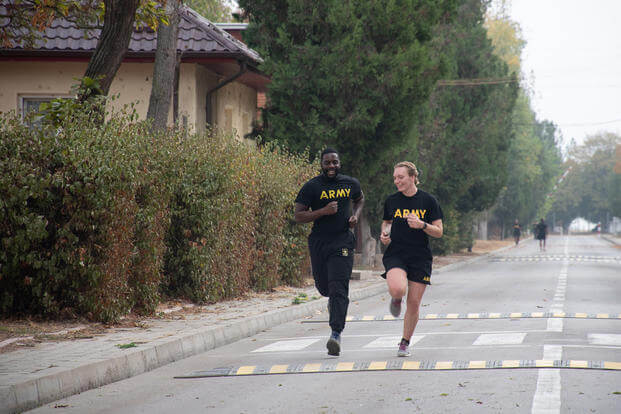When military personnel and other tactical professionals take aptitude tests for the first time, they tend to forgo pacing and give 100% effort in each event. No pace considered – just running. In a fitness test that requires two-minute sets of push-ups, sit-ups and push-ups (calisthenics) and any run longer than a mile, the idea that you can go 100% is wrong, because if you do it, you will it will probably burn out and not finish the time or distance.
If you want to achieve 100% maximum ability on a military or tactical fitness test, you must learn how to walk and stay in shape to maintain a certain pace. This goes for activities like sit-ups, running and swimming. Here’s a question from a police recruit who needs to pass an aptitude test very similar to the Navy and Air Force tests:
Good afternoon. I emailed you about abs and how to get better at them, but I wanted to know how to get my 1.5-mile time down to under 11 minutes. I’m in the police academy and I run 1.5 miles in 11:58 seconds. Thank you, Elijah
Elijah, thanks for the email. In the same way that you improve your abs, you improve your running. It’s all about getting in shape to keep up. None of this is a sprint, although you should add running and agility exercises to your weekly workouts, as these are two important elements of physical fitness for military and law enforcement personnel.
Here’s a breakdown of typical events that require pacing to get the best score:
Abs
If you want to do 80 sit-ups in two minutes, you need to learn how to do 20 sit-ups in 30 seconds. Your workouts are lots of 30 second sets until 20 reps are easy… then increase to 40 in a minute. Next thing you know, you’re doing 80 in two minutes.
Note: Many groups within the tactical community are removing sit-ups or sit-ups as part of fitness testing events and replacing them with plank pose. Obviously, there is no rhythm to planks, just building the endurance needed to hold this position for 3-4 minutes.
Running
If you’re running 1.5 miles in 12 minutes (or eight minutes per mile), your quarter-mile runs will be set at two minutes. So if you want to shave off a minute, that means each lap needs to be 10 seconds faster. Do your workouts in this time zone – neither slower nor faster – and learn to run at this pace for 11 minutes and accumulate up to 2.4 kilometers. Here are your new goal-pace workout sets:
Goal pace: 11 minutes for 1.5 miles (or a 7:20 mile pace); Your quarter-mile runs need to be 1:50 to get to an 11-minute, 1.5-mile timed run. Try this: repeat 6-8 times.
- Run 400 meters (quarter mile) at 1:50
- Walk 100 meters between sets
When this becomes easy for you, don’t try to run faster, learn how to maintain pace for a half mile or half mile:
Repeat 3-4 times.
- Run 800 meters (half a mile) at 3:40
- Walk 100-200 meters (as needed for recovery)
On a future warm-up or cool-down set, see if you can run a mile at your goal pace time of 7:20. When you can do this, you’ll be on your way to achieving your 11-minute, 1.5-mile timed run score.
Rhythm is king. Both running and sit-ups are rhythm exercises. You need to be in shape to handle this pace over whatever time or distance your test requires.
The same goes for swimming. If swimming is part of your future fitness tests, you will need to learn how to maintain a steady pace to beat the standards. For example, we typically teach one yard or meter per second when swimming any distance. Typically, these distances range from 100 to 500 meters in most units that require rescue swimming, diving, or, if your jurisdiction is surrounded by water, there may be a swimming portion of your training.
Regardless of your fitness test, there will be an event that requires self-paced practice to achieve the highest possible score. Be sure to invest time by breaking the pace into smaller chunks and increasing the distance of the test. Good luck.
Stew Smith is a former Navy SEAL and fitness author certified as a Strength and Conditioning Specialist (CSCS) by the National Strength and Conditioning Association. Visit your Fitness e-book store if you want to start an exercise program to create a healthy lifestyle. Send your fitness questions to stew@stewsmith.com.
Want to learn more about military life?
Whether you’re thinking about joining the military, looking for fitness and basic training tips, or keeping up with military life and benefits, Military.com has you covered. Subscribe to Military.com to receive military news, updates and resources directly to your inbox.
The story continues
#Prepare #Military #Aptitude #Tests
Image Source : www.military.com

